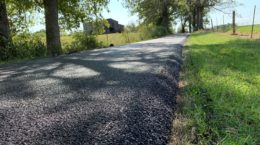In a new round of trials beginning in September 2021, BASF is testing the extremes of asphalt paving with B2Last. The company recently placed a new modified asphalt test section at the National Centre for Asphalt Technology’s (NCAT) Test Track in Opelika, Alabama.
The NCAT Test Track is the only high-speed, full-scale accelerated pavement testing facility in the world. It is a 1.7-mile oval with experimental sections sponsored by highway agencies and the transportation industry. The facility simultaneously tests numerous instrumented pavements under real environmental conditions with accelerated loading.
“In the new section, we decided to pave a material that is highly modified with B2Last combined with SBS (styrene-butadiene-styrene) due to the superior properties of the combined formulation,” says Brian Orr, Senior Asphalt Technologist for BASF Corporation. “The formulation was a 2.5% linear SBS that was crosslinked with an elemental sulfur where we added B2Last to the liquid asphalt at a 1.5% level to the material. We created a PG88-22 that was extremely stable, easily handled and kept a viscosity at or below the required 3,000 centipoise (cps) set up for the asphalt specification.”
The material was applied as part of the Phase VIII test cycle on the test track in September 2021 and the NCAT track team will run truck cycles for two to three years gathering data. The BASF test section was paved as a complement to the NCAT Additives Experiment Group of test sections. Within the test sections, strain gauges are embedded into the pavement and load plates are embedded into the base and into the bottom of the pavement. These gauges will take readings over the course of the next three years.
“NCAT is testing the mix and asphalt binder and they will report on the changes of the asphalt. They’ll do periodical scans of the pavement, inspections of the pavement by walking and documenting the cracking, and they’re going to document the performance of the material over the course of that period of time,” Orr says. “The track is going to simulate 10 to 20 years in real pavement life.”
“We want to show that the performance of pavement with B2Last is equal or better to the performance of the pavement with just SBS modification, and that modification of the binder with B2Last is not detrimental for the pavement as well,” Orr says.
Another goal of the research is to verify that BASF’s customers can use B2Last to make a highly modified material that is extremely stable and has low viscosity.
This is the second B2Last-modified asphalt to be placed on the NCAT Test Track. The first round of B2Last modified asphalt was placed down in 2020 on the test track off-ramp. The first round of data has come back with positive results.
BASF’s goal is to outperform every other additive in the Additive Experiments Group that’s being evaluated
“The initial report essentially found that B2Last modification on its own performed equally to SBS modification alone,” Orr says.
The modified asphalt research project from last year involved the paving of an offramp on the NCAT Test Track with the purpose of comparing an SBS-modified PG76-22 to a B2Last-modified PG76-22 using the same base binder.
“They were different formulations, but we wanted to show that we could make the exact same type of material with both modifications and then compare them,” Orr explains. “NCAT ran through their typical performance evaluation. Things like cyclic fatigue testing was done, rutting testing, damage characteristic curves, and they modelled the performance of the trial on the exit ramp. They found that with this base binder, it took 2.5% SBS to make an SBS-modified PG76-22. It took 2% B2Last to make an equivalent PG76-22.”
“We’ve been challenged by several agencies to determine how good can this technology be, and BASF decided to substantiate the performance of B2Last. We want to help the country build better roads more cost effectively, and more sustainably.”
According to Orr, with the test results for that specification following fairly close to each other, the continuous grade for the SBS modified was 81.1-20.2 while the continuous grade for the B2Last was 77.2-19.6.
“In summary with those results, the key finding was that both pavement sections have had roughly 54,000 Equivalent Single Axle Loads (ESALs) from May 27, 2020 through March 4, 2021. Both pavement sections are performing well with no cracking. According to the test results, there’s no difference in fill performance between the SBS modified binder and the B2Last modified binder,” Orr says. “Also, while the CTE index results were higher for the control SBS section, the statistical value of the B2Last modified section did fall within the statistical error of the SBS modified section. Resistance to cracking characteristics were very similar for the two materials.”
The tests also showed that viscosity of the B2Last-modified material was significantly lower than the SBS-modified material. These results led to the new highly modified section that was put on the NCAT Test Track in September and the new binder research underway. The asphalt modification for the 2021 NCAT Test Track trials was performed by the Hunt Refining Company based out of Tuscaloosa, Alabama.
“They supplied a typically modified 67-22 that was already modified with SBS. They also provided the B2Last material, and we injected 1.5% B2Last into a holding tank and allowed it to mix for roughly 24 hours. At that point, we made sure the material was completely reacted and transported it to trailers and moved it to the mixing plant,” Orr says.
Between the 2020 test results and performance expectations for the 2021 test material, BASF is very excited to see the results.
“We saw great things, and now on the test track it should be even better,” says Bernie Malonson, Marketing and New Business Development Manager, North American Monomers at BASF.
He says BASF is fortunate that North America has the world’s only full-scale pavement testing facility, the NCAT Test Track.
“We looked at best practices for bringing a new modification technology to market and identified partnering with NCAT as a strategic objective based on our beliefs in this technology,” Malonson says. “Based on the success of the first experiment, we chose to partner with NCAT again for their 2021-23 test cycle.”
Malonson believes that B2Last has the potential to reduce total costs while building better roads.
“We’ve been challenged by several agencies to determine how good can this technology be, and BASF decided to substantiate the performance of B2Last. We want to help the country build better roads more cost effectively, and more sustainably.”
To learn more about B2Last for paving applications, visit: https://b2lastna.basf.com.





